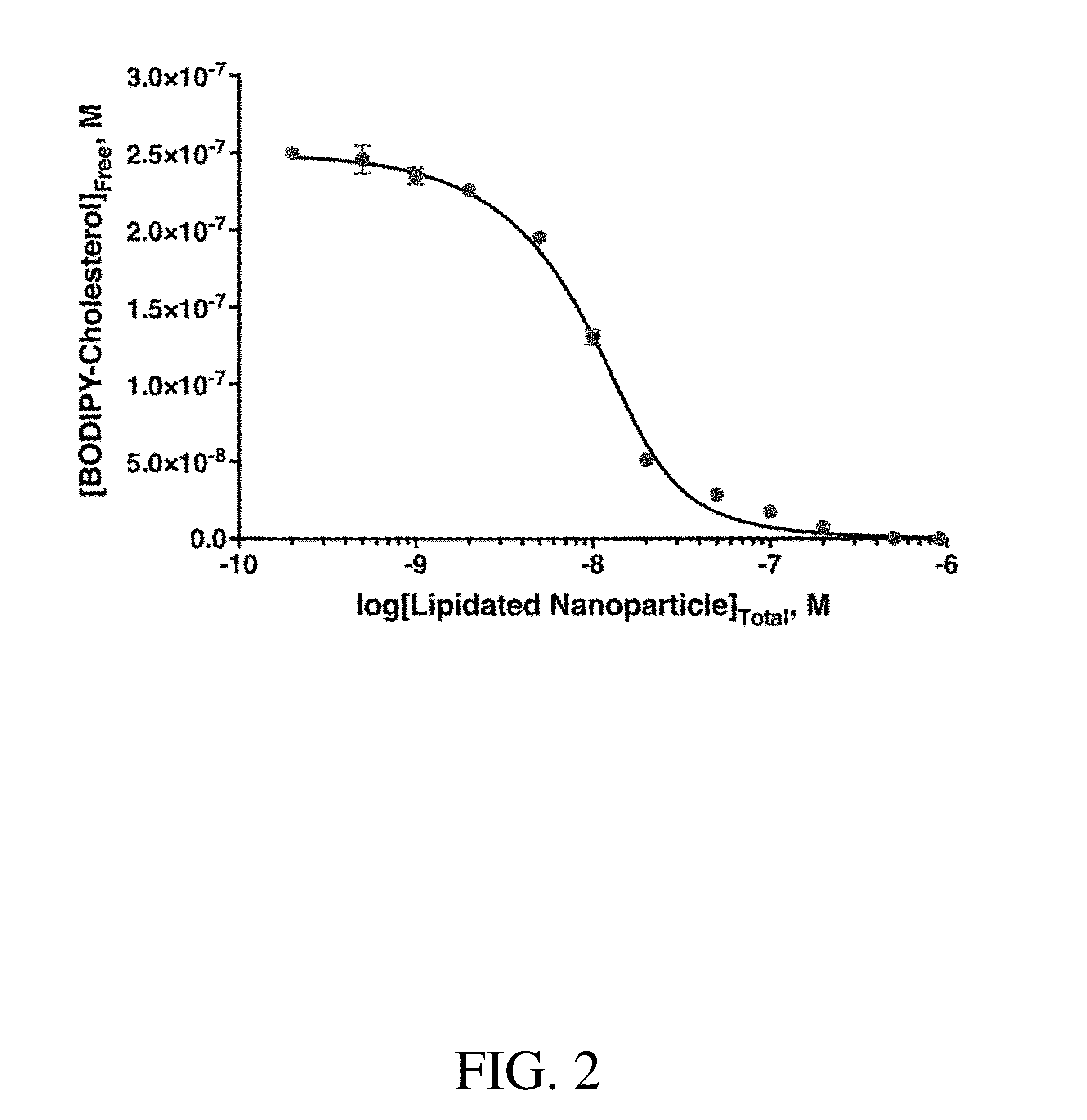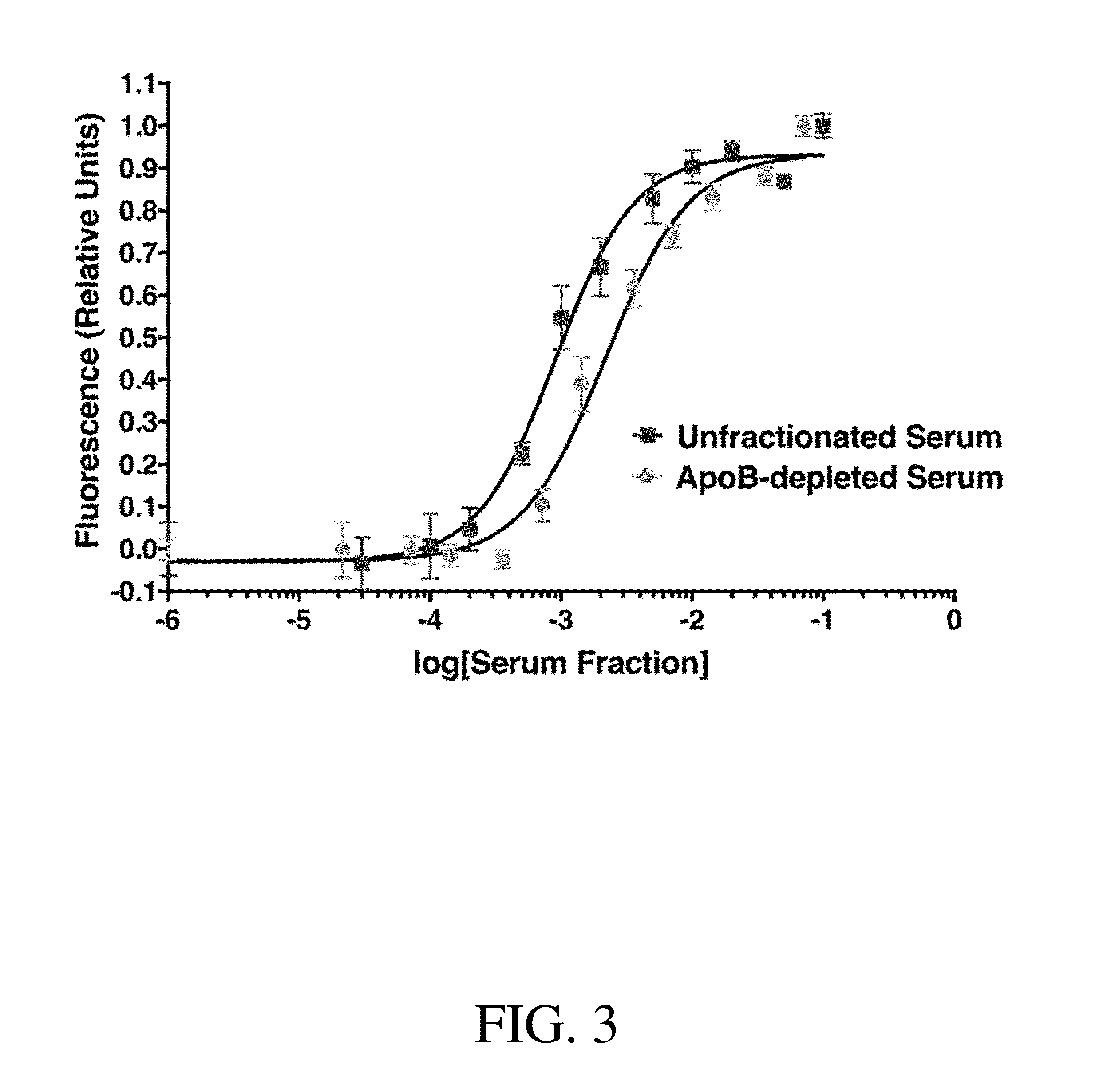Assays for measuring binding kinetics and binding capacity of acceptors for lipophilic or amphilphilic molecules
a technology of lipophilic or amphiphilic molecules and binding kinetics, which is applied in the direction of biological material analysis, instruments, diseases, etc., can solve the problems of limited clinical utility and imperfect state-of-the-art methods for determining risk, and achieve the effects of increasing the amount of acceptors, increasing the amount of structure, and increasing the signal
- Summary
- Abstract
- Description
- Claims
- Application Information
AI Technical Summary
Benefits of technology
Problems solved by technology
Method used
Image
Examples
example 1
Development of a Cell-Free Competition Assay to Measure the Dissociation Constant of Cholesterol and Human Serum Using a Biomimetic Nanostructure
Introduction
[0138]Reverse Cholesterol Transport (RCT) is a major function of high density lipoproteins and may protect against atherosclerosis. Measurement of cellular RCT improves assessment of cardiovascular risk, but current methods of measurement are limited in clinical applicability.
[0139]Here, a rapid, cell-free competition assay to measure the dissociation constant of human serum for cholesterol is described using a fluorescently labeled cholesterol analog and a biomimetic lipidated gold nanoparticle. Using this assay, the KD of human serum as well as a high density lipoprotein-enriched fraction of serum is reported. Because cholesterol binding to serum cholesterol acceptors is a significant step in cellular RCT, this assay has widespread applications for assessing cardiovascular risk.
[0140]An intriguing property of colloidal gold is...
example 2
Calculations and Nonlinear Regression Analysis
[0160](Equation1)[Chol]f=-(nNP,Chol+KD,NP-[Chol]T)+(nNP,Chol[NP}+KD,NP-[Chol]T)+4KD-[Chol]T2
[0161]Equation 1 was derived from algebraic manipulation of the following fundamental equations:
[Chol]f=[Chol]T+[Chol]Bound,NP(EquationS1)KD,NP=[Chol]f(nNP,Chol[NP]-[Chol]Bound,NP)[Chol]Bound,NP(EquationS2)
[0162]Where [Chol]Bound,NP is the concentration of cholesterol bound to the nanoparticle. Note that the term (nNP,chol[NP]-[Chol]Bound,NP) denotes the concentration of free cholesterol binding sites in the reaction.
[0163]Nonlinear regression analysis for Equation 1 was performed using GraphPad Prism 6 (La Jolla, Calif.) for the parameters nNP,Chol and KD,NP by inputing a custom equation in the non-linear regression fit package:
Y=((Ltotal−Kd−n*10̂X+(4*Ltotal*Kd+(−Ltotal+Kd+n*10̂X)̂2)̂0.5) / 2) (S3)
Where Y is free cholesterol, X is log[NP], n is nNP,chol, Ltotal is [Chol]T.
[0164]To test whether Equation 2 is valid under experimental conditions use...
example 3
Assay Measuring Patient Serum Affinity for Cholesterol Binding
[0192]An experiment was performed to compare the methods of the invention with currently used methods. The data suggest a correlation between the two assays. The assay of the invention performed consistently and in a similar manner to the currently accepted assay.
[0193]In this experiment, 14 healthy donors donated 10 ml serum for further study. This serum was collected in the conventional manner using needles and a vacutainer tube. Using this serum, a conventional cholesterol efflux assay using J774 macrophages and radiolabled cholesterol (3H-labelled cholesterol) was performed. (A. V. Khera, M. Cuchel, M. de la Llera-Moya, A. Rodrigues, M. F. Burke, K. Jafri, B. C. French, J. A. Phillips, M. L. Mucksavage, R. L. Wilensky, E. R. Mohler, G. H. Rothblat and D. J. Rader, The New England journal of medicine, 2011, 364, 127-135.)
[0194]The radiolabelled cholesterol assay was performed as follows:
[0195]Sample preparation for cho...
PUM
| Property | Measurement | Unit |
|---|---|---|
| diameter | aaaaa | aaaaa |
| volumes | aaaaa | aaaaa |
| mass | aaaaa | aaaaa |
Abstract
Description
Claims
Application Information
 Login to View More
Login to View More - R&D
- Intellectual Property
- Life Sciences
- Materials
- Tech Scout
- Unparalleled Data Quality
- Higher Quality Content
- 60% Fewer Hallucinations
Browse by: Latest US Patents, China's latest patents, Technical Efficacy Thesaurus, Application Domain, Technology Topic, Popular Technical Reports.
© 2025 PatSnap. All rights reserved.Legal|Privacy policy|Modern Slavery Act Transparency Statement|Sitemap|About US| Contact US: help@patsnap.com



